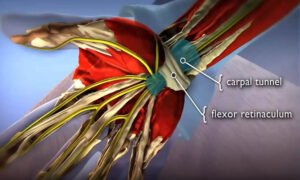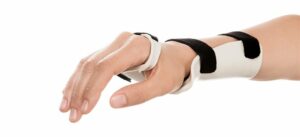Carpal tunnel is a condition that affects the hands and wrists, causing pain, numbness, and tingling. The condition is caused by compression of the median nerve, which runs through the carpal tunnel in the wrist. Carpal tunnel is a common condition, especially among office workers who spend hours typing on a keyboard. The condition can be debilitating, making it difficult to perform even basic tasks. Fortunately, there are several things you can do to prevent carpal tunnel syndrome. Here are some carpal tunnel prevention tactics that you can start using today.
Contents
What is Carpal Tunnel Syndrome?

Carpal tunnel syndrome (CTS) is a condition that causes pain, tingling, and numbness in the hand and arm. The carpal tunnel is a narrow passageway in the wrist made up of bones and ligaments. The median nerve, which runs from the forearm to the hand, passes through this tunnel. When the median nerve is compressed, it can cause CTS.
CTS is often caused by repetitive motions of the hand and wrist. It is seen more often in people who do assembly line work, typing, or other jobs that require frequent use of the hands and wrists. Women are also more likely to develop CTS than men. Other risk factors include obesity, diabetes, and pregnancy.
Symptoms of CTS include pain and tingling in the hand and wrist that may radiate up the arm. The symptoms are usually worse at night. People with CTS may also have difficulty gripping objects or making a fist.
If you think you may have CTS, see your doctor for an evaluation. A physical exam and tests of your nervous system may be done to confirm the diagnosis. Treatment options include rest, splinting of the wrist, steroid injections, and surgery.
Different Carpal Tunnel Prevention Tactics
Carpal tunnel prevention tactics vary depending on the underlying causes of the condition. If carpal tunnel syndrome is caused by repetitive motion or trauma to the wrist, strategies to prevent further injury and rest the wrist are typically recommended. Some of these tactics are:
Splinting of Wrists

One of the most common forms of carpal tunnel splinting is the wrist splint. The wrist splint is used to support your wrist and keep it from moving too much. This can help relieve the pain and other symptoms associated with carpal tunnel syndrome.
The most common type of wrist splint is the night splint. Night splints are worn at night while you sleep to keep your wrist from bending too far forward or back, which can worsen your symptoms.
Other types of wrist splints include:
• A palmar splint, which is worn on the palm side of your wrist and helps to keep your wrist from bending too far back
• A dorsal splint, which is worn on the back of your wrist and helps to keep your wrist from bending too far forward
Your doctor may recommend that you wear a wrist splint for a few hours each day or night. This is even all day and night, depending on your symptoms. You may need to wear the splint for several weeks or months to see improvement.
Taking Breaks
One of the most common carpal tunnel prevention tactics is to take breaks from repetitive motions. If you do an activity that involves repetitive motions of the wrist and hand, such as typing on a keyboard, it is important to take breaks every few minutes. This will help to reduce the amount of stress on the wrist and hand and can help to prevent carpal tunnel syndrome.
When you are taking a break, try to do some gentle stretching exercises for the wrist and hand. This can help to increase blood flow to the area and can also help to reduce stiffness and pain.
Trying a Different Position
Another carpal tunnel prevention tactic is to try a different position when doing activities that involve repetitive motions of the wrist and hand. For example, if you typically type with your wrists in a flexed position, try typing with your wrists in a neutral position. This can help to reduce the amount of stress on the wrist and can also help to prevent carpal tunnel syndrome.
Using Ergonomic Devices
Many different ergonomic devices can be used to help prevent carpal tunnel syndrome. Ergonomic devices are designed to minimize the amount of stress on the wrist and hand. Some of these devices include:
Ergonomic keyboards – these keyboards are designed so that your wrists are in a neutral position while you are typing. This can help to reduce the amount of stress on the wrist and can also help to prevent carpal tunnel syndrome.
Ergonomic mice – these mice are designed so that your hand is in a neutral position while you are using them. This can help to reduce the amount of stress on the wrist and can also help to prevent carpal tunnel syndrome.
Ergonomic computer workstations – these workstations are designed so that your wrists and hands are in a neutral position while you are using them. This can help to reduce the amount of stress on the wrist and can also help to prevent carpal tunnel syndrome.
Stretching Exercises

One of the best carpal tunnel prevention tactics is to do regular stretching exercises for the wrist and hand. These exercises can help to increase blood flow to the area and can also help to reduce stiffness and pain.
If you are going to be doing an activity that involves repetitive motions for an extended period, such as typing on a keyboard for long periods, it is important to take breaks every few minutes and to do some stretching exercises for the wrist and hand.
Using Ice
An ice pack can be a helpful carpal tunnel prevention tactic. If you start to feel pain or stiffness in the wrist or hand, you can apply an ice pack to the area for 15-20 minutes. This can help to reduce inflammation and can also help to reduce pain.
If you are going to be doing an activity that involves repetitive motions for an extended period, it is important to take breaks every few minutes and apply an ice pack to the area for 15-20 minutes. When you are finished using the ice pack, you should gently massage the area.
Massaging The Area
Massaging the wrist and hand can also be a helpful carpal tunnel prevention tactic. If you start to feel pain or stiffness in the wrist or hand, you can massage the area for a few minutes. This can help to increase blood flow to the area and can also help to reduce stiffness and pain.
Sometimes, carpal tunnel syndrome can be caused by trigger points. Trigger points are areas of muscle that are tight and can cause pain. Massaging the area around the trigger point can help to release the muscle and can also help to reduce pain.
Taking Over-the-Counter Medications
Over-the-counter medications, such as ibuprofen, can be a helpful carpal tunnel prevention tactic. These medications can help to reduce inflammation and can also help to reduce pain.
If you are going to be doing an activity that involves repetitive motions for an extended period, it is important to take breaks every few minutes. This is to take an over-the-counter medication, such as ibuprofen.
Is It Important To Use Carpal Tunnel Prevention Tactics?

Carpal tunnel syndrome is a condition that can cause pain, numbness, and tingling in the hand and arm. The condition is caused by compression of the median nerve in the wrist.
The importance of using carpal tunnel prevention tactics is that they can help to reduce the risk of developing the condition. The benefits of using prevention tactics include :
Reducing the amount of pressure on wrists
One of the most common benefits of using carpal tunnel prevention tactics is that it can help to reduce the amount of pressure on your wrists. Wrist splints, for example, can help to keep the wrist in a neutral position and prevent it from bending too far back or forward.
This can help to reduce the amount of pressure on the median nerve. This can in turn help to reduce the risk of developing carpal tunnel syndrome.
Stretching and strengthening muscles
Another benefit of using carpal tunnel prevention tactics is that they can help to stretch and strengthen the muscles in the forearm and hand. This can help to reduce the amount of stress on the median nerve and prevent it from becoming compressed.
Improving circulation
Carpal tunnel prevention tactics can also help to improve circulation in the hand and wrist. This can help to reduce inflammation and swelling in the area. This can in turn help to reduce the risk of developing carpal tunnel syndrome. Also, improving circulation can help to reduce pain and discomfort in the hand and wrist.
Helps avoid repetitive motions
Carpal tunnel prevention tactics can also help to avoid repetitive motions. This can lead to the development of carpal tunnel syndrome. For example, if you work at a computer all day, it is important to take breaks often and to avoid repetitive motions with your hands and wrists.
By using carpal tunnel prevention tactics, you can help to reduce the risk of developing carpal tunnel syndrome. However, it is important to remember that these tactics will not completely prevent the condition from developing. If you think that you may be at risk for carpal tunnel syndrome, it is important to talk to your doctor so that you can get the proper diagnosis and treatment.
Conclusion
Carpal tunnel is a common condition that can cause pain and numbness in the hand and fingers. While there is no surefire way to prevent carpal tunnel, there are several things you can do to reduce your risk. These include maintaining good posture, using ergonomic devices, and stretching regularly. If you are already experiencing symptoms of carpal tunnel, there are treatments available that can help relieve the pain. Talk to your doctor about what options might be best for you.
Physical Therapy help patients recover from pain. If you’re experiencing Back pain, Shoulder pain, Knee pain, Neck pain, Elbow pain, Hip pain, or Arthritis pain, a physical therapist at MantraCare can help: Book a physiotherapy session.


